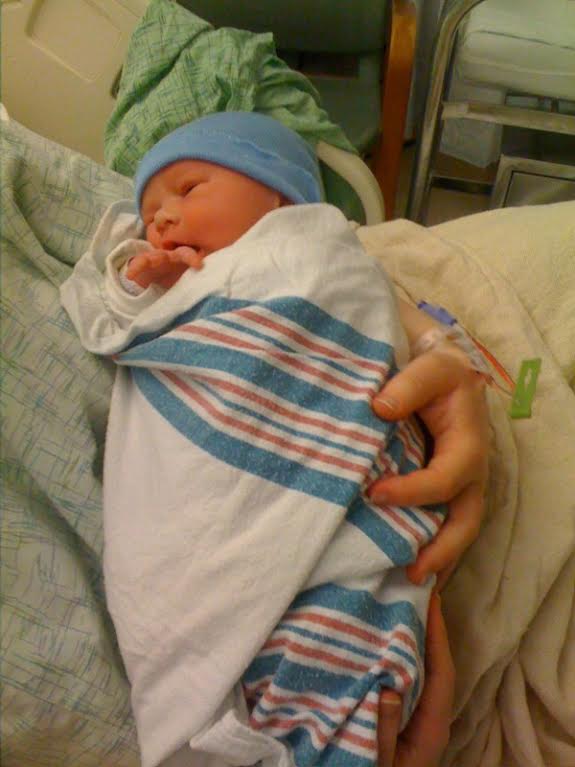By Amanda Glenn
Before I had my first baby, I had three missed miscarriages (which means I didn’t know I’d miscarried until we had an ultrasound and there was no heartbeat). As a result, I was kind of used to being told by healthcare providers that my body had failed at what it was supposed to do. Of course, most of them were very kind, and they would never have intended that I take the sad news this way. But that’s how I felt while I when devastated by the losses and unsure about whether or not I would ever have a baby.
Even when I was in labor, there were a few minutes where I still wasn’t sure I was going to have a baby – the nurse couldn’t find my baby’s heart beat and told me we needed to try an internal monitor. It turned out that his position had dropped pretty quickly and she was looking too high on my belly, but I was absolutely terrified for a few minutes there.
All of this is to say that, going into my breastfeeding experience, I had zero confidence in the ability of my body to do what it needed to do to keep a baby alive.
At the Hospital
After my son was born and everything was good, the nurse in the delivery room helped me do skin to skin and get him latched on. I was surprised at how well it seemed to go – we got him latched on on the left side and he stayed there and nursed for maybe 20-30 minutes.
But then, after that first nursing session, he basically slept for the next 24 hours. The nurses gave me a log to keep track of feeding and diapers, and they told me to make sure I was nursing him every 2-3 hours.
So, every two hours, I would dutifully attempt to wake him up and nurse. No matter what I did, I could not get him to take enough interest in my boob to actually wake up and latch on. I tried changing his diaper, stripping him down, etc., but basically the end result was always me shoving a boob in front of a sleeping baby. Who would continue to sleep.
After the first day, he did wake up a bit more and seemed to be hungry, so we were able to give nursing a go. However, I really struggled with the holds and with getting him latched on. Basically, I would attempt it on my own and then have to call a nurse for help. They were very nice, and had a lot of good advice and would get me situated with a bunch of pillows and everything – but they all told me different ways to hold him (football vs cradle) – and I was so tired because I hadn’t slept in three days that I remember a lot of times I just stared at them while they talked without being able to actually take any of it in.
By the time we left the hospital, my son had lost 8% of his birth weight, and the pediatricians encouraged me to “triple feed” – meaning that after every nursing session, I should top my son off with either a bottle of pumped milk or formula and then pump.

Seeing the Lactation Consultant
When we got home, I broke out my brand-new Medela Freestyle and attempted to figure out how to use it. I had no idea what the difference was between the letdown and expression modes and was too tired to comprehend the instructions.
Once I got the hang of it, I started triple feeding every three hours. It. Was. Exhausting.
Generally, what happened when I was triple feeding was that my baby would nurse for 40-60 minutes and fall asleep. I would then give him 2-3oz of pumped milk – which he would wake right up for and chug like a frat baby before passing out again.
Then I’d pump. The whole process took about an hour and a half, and then I would have another 1.5 hours before I had to start the whole process over again.
I found a lactation consultant and scheduled an appointment for her to come to my house. She was so helpful – we weighed my son before the feeding, she showed me a new hold (the cross cradle) and I fed him while she talked. When we weighed my baby after he finished nursing, we found he had taken 3 ounces. She told me to just nurse from then on, that we were doing great, and that I could stop triple feeding.
Not Gaining Enough Weight
After a few days, I had a weight check appointment with my son’s pediatrician. (She wanted us to come in for weight checks until my son was back up to his birth weight.) She had told me that we were looking for him to have gained about an ounce a day, but when she put him on the scale, he hadn’t gained as much weight as she would have liked. She was reassuring and told me to mostly just keep doing what I was doing but maybe try waking him up and feeding him more often.
I walked home from the appointment with my baby in the stroller feeling like I had totally failed him and, once again, like I had no idea what I was doing and that my body was not to be trusted at keeping a baby alive. (Obviously, there were a lot of postpartum hormones and anxiety at play here, plus lingering trauma from my miscarriages.)
I was so upset by the appointment that I decided to exclusively pump, because I wanted to make sure he was getting enough milk to thrive and I just wasn’t confident in my ability to do that via nursing.

Deciding to Exclusively Pump
When I first started exclusively pumping, it was like triple feeding, but without the nursing step. I did try to keep at least one nursing session a day so that maybe we could transition back to it at some point, but I starting dreading them and eventually stopped.
As much work as exclusive pumping was, it was faster than triple feeding, and being able to see exactly how much he was eating really helped my anxiety. I spent the next 13 months as an exclusive pumper.
Click here for part 2 and here for part 3.
Amanda has three children (7, 5, and 2) and has spent a total of 44 months of her life hooking herself up to a breast pump. She writes a blog about exclusive pumping (exclusivepumping.com) and lives in Chicago with her family. You can join her support group for Exclusively Pumping Mamas.












